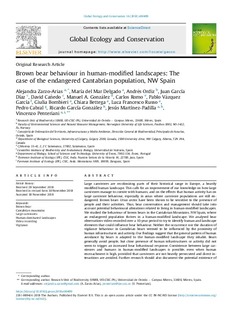| dc.contributor.author | Zarzo-Arias, Alejandra | |
| dc.contributor.author | Delgado, Maria Del Mar | |
| dc.contributor.author | Ordiz Fernandez, Andres Avelino | |
| dc.contributor.author | Diaz, Juan Garcia | |
| dc.contributor.author | Canedo, David | |
| dc.contributor.author | Gonzalez, Manuel A | |
| dc.contributor.author | Romo, Carlos | |
| dc.contributor.author | Garcia, Pablo Vazquez | |
| dc.contributor.author | Bombieri, Giulia | |
| dc.contributor.author | Bettega, Chiara | |
| dc.contributor.author | Russo, Luca Francesco | |
| dc.contributor.author | Cabral, Pedro | |
| dc.contributor.author | Gonzalez, Ricardo Garcia | |
| dc.contributor.author | Martinez-Padilla, Jesus | |
| dc.contributor.author | Penteriani, Vincenzo | |
| dc.date.accessioned | 2019-02-26T12:34:03Z | |
| dc.date.available | 2019-02-26T12:34:03Z | |
| dc.date.created | 2019-02-24T21:08:46Z | |
| dc.date.issued | 2018 | |
| dc.identifier.issn | 2351-9894 | |
| dc.identifier.uri | http://hdl.handle.net/11250/2587482 | |
| dc.description.abstract | Large carnivores are recolonizing parts of their historical range in Europe, a heavily modified human landscape. This calls for an improvement of our knowledge on how large carnivores manage to coexist with humans, and on the effects that human activity has on large carnivore behaviour, especially in areas where carnivore populations are still endangered. Brown bears Ursus arctos have been shown to be sensitive to the presence of people and their activities. Thus, bear conservation and management should take into account potential behavioural alterations related to living in human-modified landscapes. We studied the behaviour of brown bears in the Cantabrian Mountains, NW Spain, where an endangered population thrives in a human-modified landscape. We analysed bear observations video-recorded over a 10-year period to try to identify human and landscape elements that could influence bear behaviour. Neither the occurrence nor the duration of vigilance behaviour in Cantabrian bears seemed to be influenced by the proximity of human infrastructures and activity. Our findings suggest that the general pattern of human avoidance by bears is adapted to the human-modified landscape they inhabit. Bears generally avoid people, but close presence of human infrastructures or activity did not seem to trigger an increased bear behavioural response. Coexistence between large carnivores and humans in human-modified landscapes is possible, even when human encroachment is high, provided that carnivores are not heavily persecuted and direct interactions are avoided. Further research should also document the potential existence of other responses to human presence and activity, e.g., hunting, traffic noise, and measuring stress levels with physiological indicators. | nb_NO |
| dc.language.iso | eng | nb_NO |
| dc.rights | Attribution-NonCommercial-NoDerivatives 4.0 Internasjonal | * |
| dc.rights.uri | http://creativecommons.org/licenses/by-nc-nd/4.0/deed.no | * |
| dc.title | Brown bear behaviour in human-modified landscapes: The case of the endangered Cantabrian population, NW Spain | nb_NO |
| dc.type | Journal article | nb_NO |
| dc.type | Peer reviewed | nb_NO |
| dc.description.version | publishedVersion | nb_NO |
| dc.source.volume | 16 | nb_NO |
| dc.source.journal | Global Ecology and Conservation | nb_NO |
| dc.identifier.doi | 10.1016/j.gecco.2018.e00499 | |
| dc.identifier.cristin | 1680232 | |
| cristin.unitcode | 192,14,0,0 | |
| cristin.unitname | Miljøvitenskap og naturforvaltning | |
| cristin.ispublished | true | |
| cristin.fulltext | original | |
| cristin.qualitycode | 1 | |

